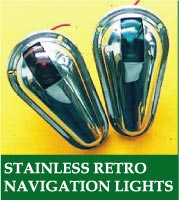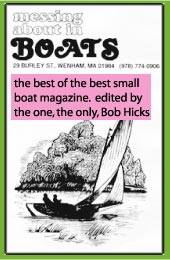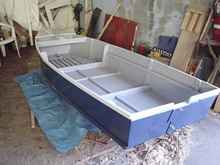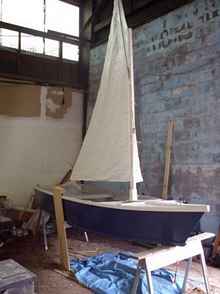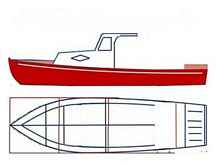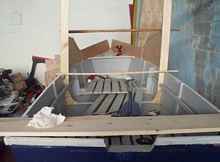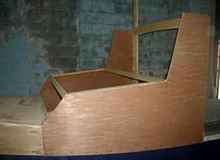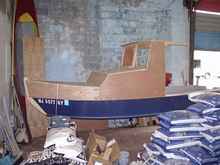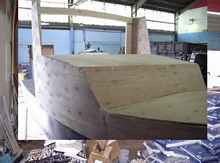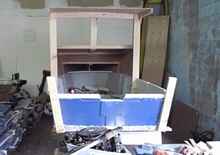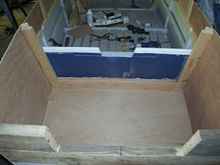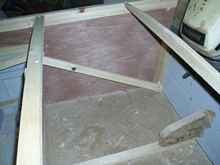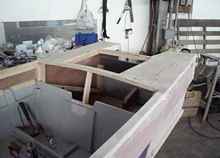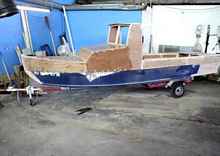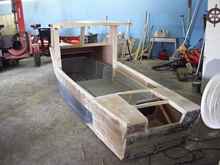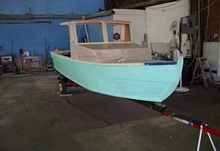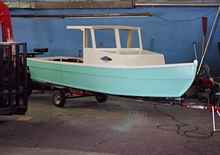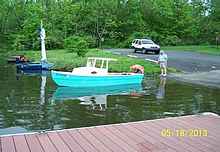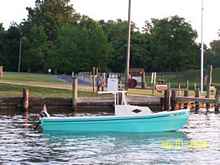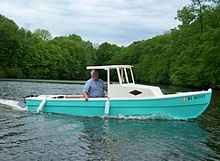In preparation for the 2012 Eastern Messabout held at Elk Neck State Park in Maryland I needed something that would float. Still in the midst of two and a half years of unemployment, funds were not available to build something too elaborate. I had some leftover plywood from previous projects and purchased some additional framing material. I designed and built a 13 1/2 foot skiff.
I called her Rachel after my granddaughter, added a spritsail rig and headed for Maryland.
The sail rig didn't work out so well so I motored about for the rest of the event. Later in the fall I bought a trolling motor and battery and used her that way for the rest of the season. Having finally secured employment full time in the late fall I started thinking about the 2013 event. I wondered what I could do with the skiff to make it a little bit larger and more comfortable and perhaps able to take a larger outboard. I spent much of the winter drawing on the computer using the existing skiff as a basis hoping to come up with a design that would meet my needs for 2013. Since I am a native of Maine I thought a lobster boat replica might be kind of fun to have.
In order to get the proportions correct I realized that I had to lengthen the hull a bit. I drew her 2 1/2 feet longer and much higher on the sides in order for her to look right.
I built a model of the skiff first and then added the new parts in the order of the build. It looked good so I wrote the dimensions on the model and actually used it to build. I began construction by sanding the rails and the stern section so the new parts could be added.
The skiff had a rather flat sheer and I wanted to improve the looks so I built in more sheer. I decided to attach the new sides, made from luan, onto the rails rather than try to splice them into the old sides. I wanted to retain the stiffness if possible. The topsides and the cabin were cut out based on the dimensions of the model so I would be sure of the lobster boat effect being in the right proportions.
I made a curved stem, which is typical of a Maine lobster boat, and fitted it into the new bow pieces. Next I framed the forward deck, the cabin top, and the top of the pilot house with the same curvature. Then the tops were enclosed with luan for lightness.
Having obtained an old Evinrude 9.9 I wanted to insure that the new addition in the stern would be rugged enough.
Since I left the original transom in place I cut 2x4s to fit as a frame for the new sides and bottom of the extension. Giving the pieces the proper bevel they were glued and screwed into place onto the old transom.
The skiff had external chine logs. I cut them back 18 inches and spliced new logs for the aft section. Likewise I extended the rails back to the new transom. Carefully the new pieces were added for the bottom and the sides of the new aft section. I then added a lamination of 2 x 6 pieces to make a new strong transom. The transom was braced with a knee in the bottom and I put braces from the bottom corner at the sides reaching to the top corner of the original transom. It resulted in a very strong addition to the boat which could easily handle the 9.9 Evinrude.
Next the framing for the rear deck was added, which had the same curvature as the other new parts. The new rails were mounted and shaped. Next the screw holes on the entire exterior were filled and sanded.
West System epoxy was used to fiberglass all of the new wood that had been added to this point. It was late April and I only had about four weeks left to before the messabout.
I had intended to do more sanding and another coat at least of epoxy in order to fill the weave in and remove any ripples that had occurred. I needed to stop at that point because I had barely touched the interior of the boat and needed what time was left to finish the interior so that it would be as usable as possible.
Primer and a finish coat of the paint was put over the not yet smooth surface of the exterior of the boat. I will have to go back at a later time and do a lot of sanding with additional priming and a couple more coats of finish paint. It's acceptable now with it's 50 foot workboat finish.
When I returned after the mini messabout I decided that the 9.9 needed further work before it was ready for prime time.
I decided to get a lighter motor and was able to find locally on Craigslist a four hp Johnson that weighed about half as much. I first used the 4 hp at The Eastern Messabout which was held on May 31 through June 2, 2013. It worked very well. I had rigged a tiller extension for steering and also had rigged a throttle rod - the Johnson has a side throttle. I was able to get 5 mph at full throttle which I thought was quite good.
All in all I am pleased with Jeff. She is a nice improvement over the 13 foot skiff of last year. I was able to prove to myself that a skiff can be converted into a larger more versatile boat.
Remember you too can build a boat, sure you can!
|


